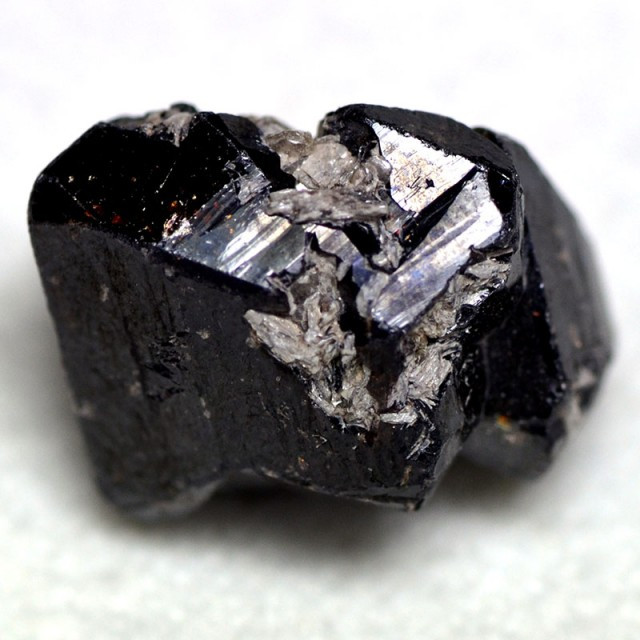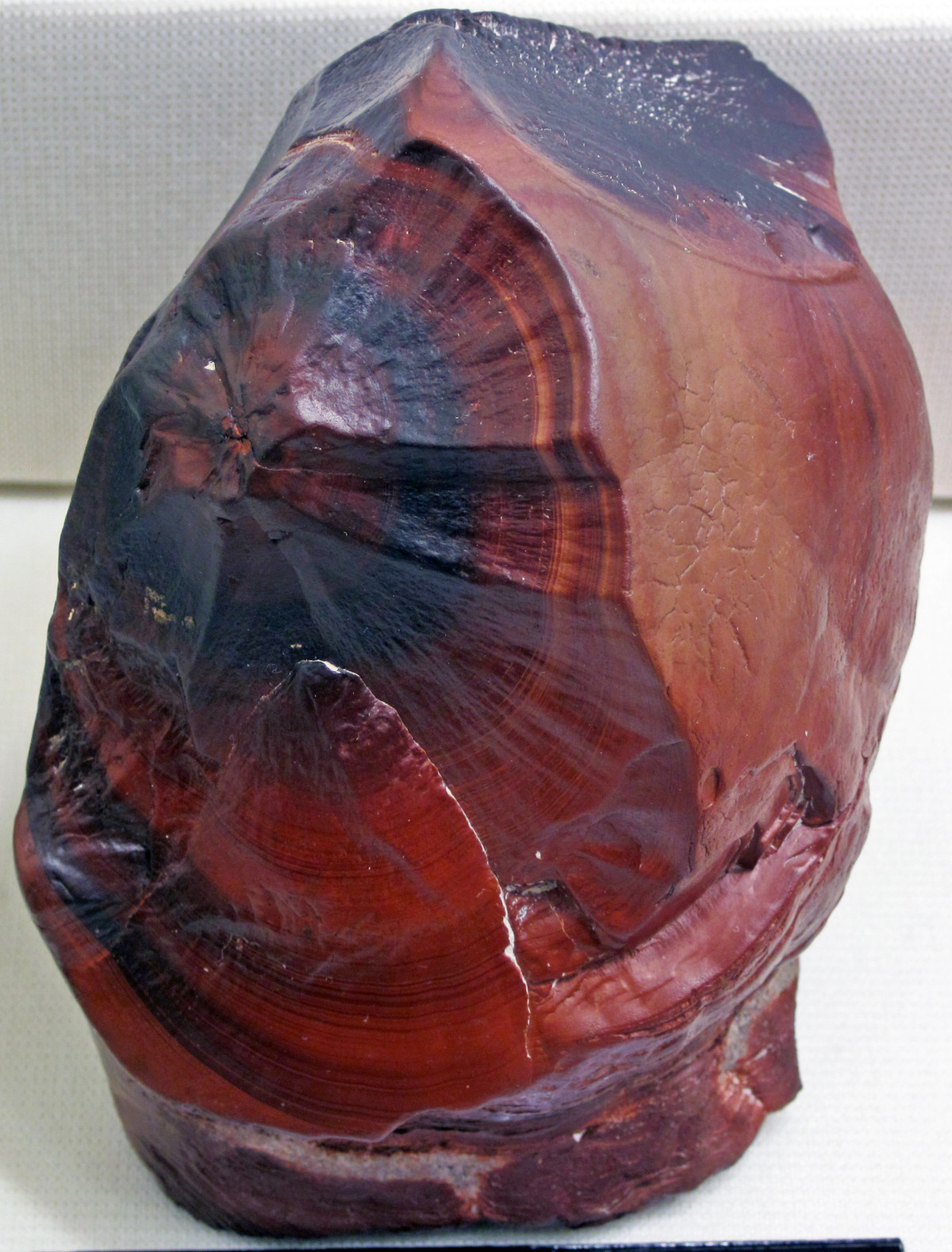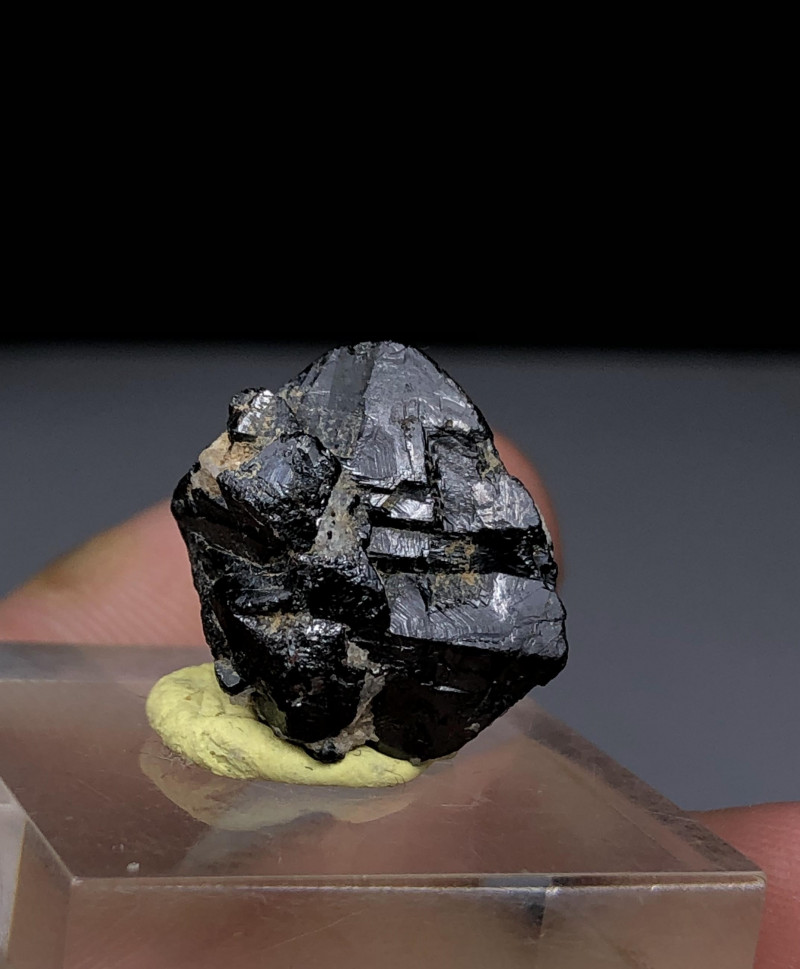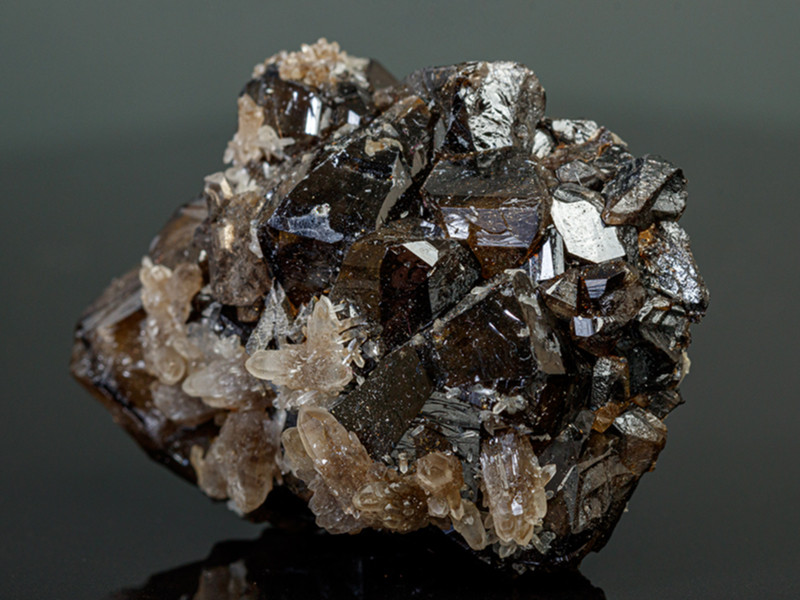
Cassiterite Gemstone: Properties, Meanings, Value & More
 Cassiterite is a lustrous mineral used to acquire tin for thousands of years. It’s also a gemstone with stunning dispersion (colorful sparkle) that handily beats out that of diamond.
Cassiterite is a lustrous mineral used to acquire tin for thousands of years. It’s also a gemstone with stunning dispersion (colorful sparkle) that handily beats out that of diamond.
Is cassiterite rare or common? As a mineral, cassiterite is common and found all over the world. However, facetable, gem-quality crystals are very rare and typically tiny.
Both industrially and gemologically, cassiterite has beneficial attributes that make it an underrated delight, especially for collectors. This guide will teach you everything you need to know about cassiterite jewelry, gemstones, uses, and prices!

About Cassiterite Stone
Cassiterite is a semi-precious gemstone, though its dispersion (fire) is almost double the dispersion of the precious gemstone diamond. It’s a zodiac stone for Sagittarius and ties to 2 and 8 in numerology.
The most common nickname for cassiterite is tinstone, but some other monikers are:
Tin spar
Ruby tin
Nadelzinners (Frisian for “tin ore” or “crystal tin”)
Needle-tin ore
Sparable tin
Stannum caliciforme (Latin for “cup-shaped tin”)
What is the use of cassiterite beyond gemstones? As you may have guessed from the names above, the main cassiterite uses have to do with tin.
Throughout history and still today, cassiterite is the number-one source of tin metal. Why? Well, the mineral is made up of 78.6 percent tin!
Where does all that cassiterite tin go? The most widespread use of tin worldwide is electronics — including cell phones — where tin is ideal for soldering on circuit boards. Its low melting point makes the bonding involved in soldering much easier.
Other uses for tin extracted from cassiterite include containers and polishing powders.

Cassiterite Specifications & Characteristics
As a tin oxide mineral, the cassiterite formula is SnO2. Tantalum, iron, and niobium are the most common impurities. You may also see impurities of:
Zinc
Manganese
Tungsten
Germanium
Scandium
Indium
Gallium
Cassiterite is in the rutile mineral group. You may recognize rutile from the gorgeous rutilated quartz stone, where it penetrates quartz as golden needle-like inclusions. Rutile is the most common mineral in the group and joins cassiterite as an important source of metal — in rutile’s case, it’s a titanium dioxide mineral and an important titanium ore.
One prized aspect of cassiterite among collectors is its variety of crystal habits. It forms with rare twinning crystals like elbow twins (bent at 60 degrees), penetration twins (intergrown past each other), and contact twins (joined together at the base).
This tin stone is also beloved for its other crystal habits, like pyramidal or bipyramidal, reniform (kidney-shaped) with fibers radiating out, and botryoidal (resembling grape clusters).
When it comes to identification...

How Can You Tell If A Stone is Cassiterite?
The easiest identifier is cassiterite’s density, or specific gravity. Cassiterite is quite dense at 6.7-7.1, making it heavier than other stones of similar size dimension-wise.
Some other distinguishing factors are:
Refractive Index: If you’re using a refractometer, cassiterite’s refractive index will be “over the limit” of the tool.
Color Zoning: Unlike similar gems, cassiterite may have zones of color.
Luster: Faceted cassiterite gems are usually adamantine (diamond-like), which is a rare luster for most gems.
While diamonds have a similar luster, they’re much harder (at 10 on the Mohs hardness scale) than cassiterite. However, cassiterite’s dispersion at 0.071 is significantly higher than diamond’s at 0.044.
Sphalerite also has a similar luster and color, but its dispersion is higher (at 0.156) while its hardness (3.5-4) and density (3.9-4.1) are lower.
Another pair of similarly high-dispersion, high-density stones are cinnabar and stibiotantalite, but both stones are softer and denser than cassiterite.
Here is the mineral data for cassiterite:
Mohs hardness: 6-7
Color: Black, brown, red, gray, yellow, green, white, colorless, purple, yellowish-brown, wine red, reddish-brown
Crystal structure: Tetragonal
Luster: Adamantine, vitreous (glassy), submetallic; Sometimes greasy on fractures
Transparency: Transparent to opaque; Usually opaque, thin crystals translucent
Refractive index: 2.006-2.101
Density: 6.98 - 7.01
Cleavage: Imperfect on [100], indistinct on [110]
Fracture: Irregular/Uneven or subconchoidal
Streak: White to brownish
Luminescence: Rarely fluorescent - yellow in SW-UV
Birefringence: 0.098
Pleochroism: Present; Usually weak (sometimes strong) dichroism in green, yellow, red, and/or brown; Pleochroic “haloes” sometimes present
The crystal habits of cassiterite aren’t only attractive properties, they’ve also led to different varieties.
 Image Credit: James St. John | Flickr
Image Credit: James St. John | Flickr
Types of Cassiterite
Like its nicknames and industrial uses, many cassiterite varieties are associated with tin. In fact, only one of its varieties does not have “tin” in its name. Let’s look at each type below.
Wood Tin
Wood tin is a microcrystalline (or cryptocrystalline) variety of cassiterite. If you’re familiar with chalcedony and quartz, wood tin is to chalcedony as cassiterite is to quartz.
This variety has concentric, color-banded rings of fibrous texture that resemble the rings you see in a tree stump.
Dough Tin
Dough tin is a white variety from Cornwall, England, that resembles uncooked bread dough in texture and color, hence the name.
Toad’s Eye Tin
Toad’s eye tin is similar in color and somewhat in texture to dough tin, but it’s set apart by its grape-like botryoidal or kidney-like reniform habits. It also has radiating fibrous and color-banding, making it look somewhat similar to a toad’s eye.
Stream Tin
Stream tin is a round variety worn down by stream water.
Ainalite
The only variety without “tin” in its name, ainalite is a type of cassiterite that is up to 10 percent iron tantalum pentoxide (FeTa2O6). Its first source was Finland.
You’ve got the basics done, so it’s time to get into cassiterite’s symbolism and past.

Cassiterite Meaning & History
The meaning of cassiterite is associated with manifestation, wisdom, and protection. The stone also symbolizes divine light, nicknamed a “Stone of Divinity.”
Throughout ancient times, the main source of tin was cassiterite. Specifically, mining cassiterite for tin dates back to the Copper Age (3,500 to 2,300 BC). Cassiterite tin was also among the first metal alloys.
As far as its name, there are two explanations given depending on who you ask. One is that it comes from the Greek kassiteros, meaning “tin” for... obvious reasons.
The second explanation comes from the pre-Roman Cassiterides, islands without an agreed-upon location (though probably near Spain).
In the 1400s, miners started extracting cassiterite from deposits in Bohemia (Czechia) and Saxony (Germany). Mining peaked in these areas during the 1600s.
German chemist Martin Heinrich Klaproth published the first description of cassiterite in 1797. By the 1700s and 1800s, Cornwall in England became the new hot spot for cassiterite production.

Cassiterite Healing Properties
Like other gemstones, cassiterite’s coloring influences its abilities as a healing stone. Most of these crystals are black, joining other black gemstones in offering grounding and balancing.
Brown cassiterite, like other brown gemstones, opens the root chakra to bring in protection and stability. Yellow or green cassiterite is also a chakra stone for aligning the sacral and heart chakra, allowing your emotions and desires to harmonize.
Let’s take a look at the specific physical and emotional healing benefits of cassiterite.
Physical Healing
Physically, cassiterite is said to treat the heart and lungs, strengthening breathing for people who struggle with disorders like asthma. It’s also believed to stimulate the brain and improve memory.
Emotional Healing
Emotionally, cassiterite crystals can help you manifest your goals and solve problems along the way. It’s particularly good for analytical or mathematical thinking.
Additionally, crystal healers use this stone for increasing optimism, grounding, and resilience. For anyone recovering from the pain of rejection or abandonment, cassiterite can help you have a fresh, brighter start.

Cassiterite Gemstone Properties
Experts determine the value of cassiterite by looking at where it falls on color, cut, clarity, and carat weight. They may also examine for any enhancements.
Color
Cassiterites with strong coloring are most valuable, not only because they’re more attractive, but also because they bring out the gem’s high sparkle and luster. Even the pleochroism is best in intensely colored gems.
The most common colors are brown and black or brownish-black. Surprisingly, cassiterite is allochromatic, meaning its purest form is colorless. The browns and blacks come from iron impurities.
Rare hues of cassiterite are wine red, reddish-brown, yellow-brown, and purple. Unlike many stones, pale-colored specimens are often more valuable than darker-colored ones.
Cut
The proper faceted cut can make cassiterite sparkle and shine brighter than diamonds. Common faceted cuts are emerald, oval, cushion, and round shapes.
Wood tin cassiterite is usually cut as cabochons, freeform shapes, or carvings. The banding makes these great decor pieces.
Additionally, cassiterite with attractive crystal habits may be sold rough (uncut).
Clarity
Most cassiterite rough contains inclusions.
Often, you’ll see veils (healed fractures in the crystals that resemble fingerprint inclusions) or two-phase inclusions (cavities in the crystal filled by liquid and vapor). Bolivian cassiterite sometimes has needle-like tourmaline inclusions.
Though rarer, cassiterites without visible inclusions to the naked eye (a.k.a. eye-clean) are most valuable.
Carat Weight
Eye-clean cassiterite gems are almost always under 1 carat. Cabochons created from massive material can be larger.
Bolivia has produced light to dark brown cassiterite material yielding 15-carat faceted gems with good clarity and 25-carat gems with so-so clarity. Colorless cassiterite gems weighing more than 2 carats are highly sought-after.
Treatments & Synthetics
Though typically untreated, some “star cassiterite” specimens studied by the Gemological Institute of America (GIA) in 2001 showed artificial treatment. These stones were scratched with lines resembling the parallel fibers that produce asterism.
Because asterism is a valuable quality, be wary of “star cassiterite” specimens for sale, as the stone doesn’t naturally display this optical phenomenon.
Scientists have manufactured synthetic cassiterite. It’s mostly created for research purposes, but these may soon emerge in the gem market.
Back to the real deal, how does natural cassiterite form?

Cassiterite Formation & Sources
Cassiterite usually forms when water carrying dissolved elements settles into rock veins and evaporates, leaving behind the elements to crystallize.
Most cassiterite forms inside granite, rhyolite, and pegmatite veins. It’s also found in alluvial placer deposits, where water carries minerals to a new area (common for the stream tin variety).
Mining Locations
Where is cassiterite found in the world? Today, most gem-quality cassiterite comes from Bolivia, followed by Russia and China. Other major sources are Burma, Nigeria, Indonesia, Thailand, and Malaysia.
Smaller cassiterite sources include:
Australia
Canada
Czechia
Japan
Mexico
Pakistan
Portugal
Spain
Sri Lanka
Tasmania
UK (England)
USA (Alaska, California, Nevada, South Carolina, South Dakota, Virginia, Washington)
Vietnam
Thinking of browsing some cassiterite for sale? Then let’s discuss what to expect price-wise.

Cassiterite Price & Value
Cassiterite minerals used for extracting tin and facetable rough for gemstones come at very different price points. The former is more abundant and often priced by larger amounts. The cassiterite price per kg for ore material (that’s not gem-quality) is around $3-$5 per kg.
At wholesale, faceted cassiterite is around $80 per carat. Rough black crystals are much more affordable, fetching between $0.10-$0.50 per carat. However, lustrous, rarer raw crystals can sell for $85 to $400.
Opaque tumbled cassiterite is usually around $3-$5.
Cassiterite Care and Maintenance
Luckily, cassiterite is a relatively hard and durable gemstone, making it great for daily wear. Still, we recommend protective settings for more vulnerable options like bracelets or rings to prevent scratches.
Cassiterite’s durability also makes gemstone care pretty straightforward. The safest cleaning method is with warm water, mild soap, and a soft toothbrush.
Captivate in Cassiterite!
While cassiterite’s importance mostly lies in its tin content, its gemstones are equally beneficial in terms of lifting your spirits and keeping you grounded. Snag some cassiterite jewelry and you’re sure to captivate any passerby!
Search the Gemstone Encyclopedia
Related Auctions
Related Articles
Originally the Birthstones or gemstones were associated with a zodiac sign or the month of a individuals birth. Find out what your stone is and view the stones we have for sale
8th Feb 2021
There are dozens of quartz and chalcedony gems with various colors and patterns. Learn all about quartz properties and every type of quartz, from amethyst and agate to plasma and phantom quartz!
15th Oct 2020
Hackmanite is a pink to violet sodalite gem known for its unique color-change and luminescence. Learn why hackmanite is special, from its rare qualities to the types of hackmanite jewelry available.
28th Mar 2018
Latest Articles
Yugawaralite is a rare colorless, white, or pinkish zeolite crystal named for its discovery in Yugawara, Japan. Here we uncover the multifaceted history, properties, prices, and uses of yugawaralite.
24th Mar 2025
Simpsonite is a lesser-known mineral known on the gem market for its durability, yellow-orange color, and rarity. Discover all the properties, uses, prices, and history of simpsonite.
3rd Mar 2025
Kurnakovite is a colorless crystal related to inderite and rarely faceted but known among collectors. Explore the mineral traits, history, prices, and more in this kurnakovite guide.
17th Feb 2025
Article Categories
How To's is where you will find helpful articles from gem Rock Auctions on how to cut gemstones, select gemstones and buy gemstones.
9 Articles






